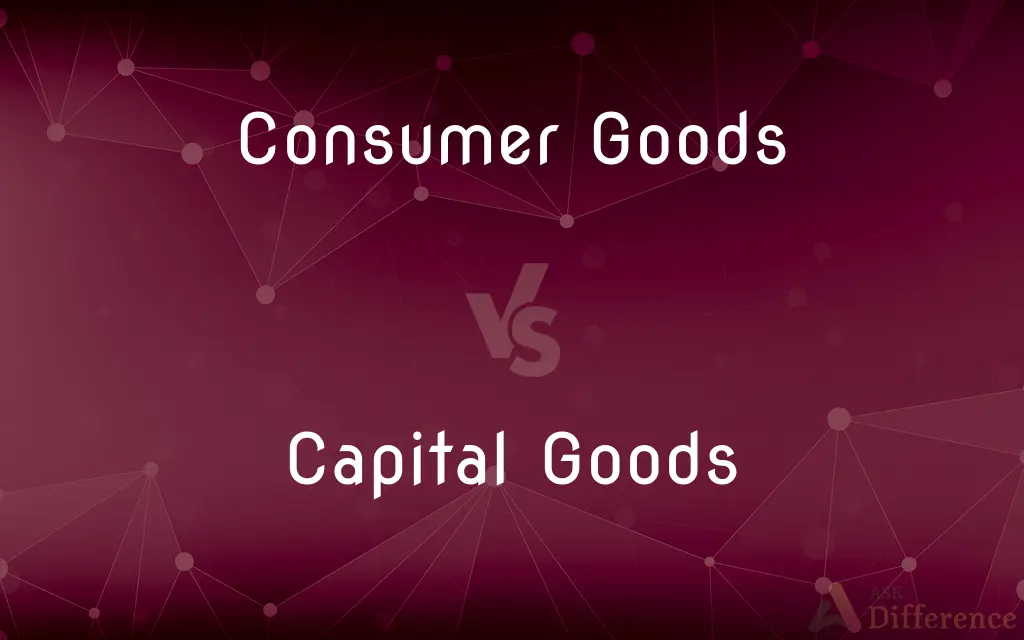Consumer Goods vs. Capital Goods — What's the Difference?
By Tayyaba Rehman — Published on October 23, 2023
Consumer Goods are products bought for consumption, while Capital Goods are products used to produce other goods or services.

Difference Between Consumer Goods and Capital Goods
Table of Contents
ADVERTISEMENT
Key Differences
Consumer Goods encompass items directly used by end consumers, typically without further transformation. In stark contrast, Capital Goods are machinery, equipment, or other products utilized by businesses to produce goods or services, not for direct consumption.
Consumer Goods, like food or apparel, serve the immediate needs or desires of consumers. On the other side, Capital Goods, such as manufacturing equipment or computers, are instrumental in the production processes, helping generate consumer products or services.
A notable distinction between Consumer Goods and Capital Goods is the duration of utility. While Consumer Goods are often rapidly consumed or wear out after use, Capital Goods have a prolonged lifespan, facilitating production over an extended period.
It's essential to note that the same product might be classified differently based on its use. A laptop, for instance, can be a Consumer Good for personal use. Yet, when used in a business setting for operations or management, it transforms into a Capital Good.
Understanding both Consumer Goods and Capital Goods is pivotal for economies. The former directly relates to daily life and immediate consumption, whereas the latter focuses on production capacity, fueling economic growth in the long run.
ADVERTISEMENT
Comparison Chart
Purpose
For direct consumption.
For producing other goods/services.
Duration of Utility
Often short-lived or perishable.
Longer lifespan.
Users
End consumers.
Businesses and industries.
Nature
Final product.
Intermediate product.
Economic Significance
Indicate consumer demand.
Reflect production capacity and long-term investment.
Compare with Definitions
Consumer Goods
Products that don't require further production for consumption.
Shoes are Consumer Goods worn for comfort and style.
Capital Goods
Goods with a utility extending over long durations.
Construction cranes are Capital Goods used in building infrastructures.
Consumer Goods
Finished products for direct consumption.
Television sets are Consumer Goods offering entertainment.
Capital Goods
Assets aiding the production of consumer goods/services.
Agricultural tractors are Capital Goods vital for farming.
Consumer Goods
Items bought for personal or household consumption.
Groceries are essential Consumer Goods for households.
Capital Goods
Machinery or equipment used in production processes.
Industrial robots are Capital Goods improving manufacturing efficiency.
Consumer Goods
Products intended for immediate use by consumers.
A smartphone is a popular Consumer Good.
Capital Goods
Items contributing to a firm's production capacity.
Printing presses are Capital Goods crucial for publishing businesses.
Consumer Goods
Goods satisfying the immediate needs of individuals.
Cosmetics are Consumer Goods enhancing personal appearance.
Capital Goods
Products not consumed but used to generate other goods.
Power plants are Capital Goods producing electricity for various needs.
Common Curiosities
Why are Capital Goods significant for economies?
Capital Goods enhance production capacity, indicating long-term investments and fueling economic growth.
Can a product be both a Consumer and Capital Good?
Yes, a product's classification can change based on its use, like a laptop for personal or business purposes.
Are all durable goods Capital Goods?
No, durability doesn't solely define Capital Goods. Durable Consumer Goods, like refrigerators, serve consumers directly.
Are all Capital Goods expensive?
While many Capital Goods like machinery can be costly, not all are expensive. Prices vary based on utility and complexity.
What are Consumer Goods?
Consumer Goods are products purchased for immediate consumption by end users.
Why is the distinction between Consumer and Capital Goods essential?
The distinction helps in economic analyses, taxation, and understanding consumption versus production patterns.
How do Capital Goods differ from Consumer Goods?
Capital Goods are used to produce other goods/services, while Consumer Goods are for direct consumption.
Are cars considered Consumer Goods?
Generally, personal vehicles are Consumer Goods, but when used for business, they can be Capital Goods.
How do Consumer Goods impact economies?
Consumer Goods indicate consumer demand, affecting production decisions and economic indicators.
Is jewelry considered a Consumer Good?
Yes, jewelry is typically considered a Consumer Good as it's bought for personal adornment.
What is an example of both a Consumer and Capital Good?
A computer can be a Consumer Good for personal tasks but a Capital Good in a business setting.
Which sector sees a higher demand when Consumer Goods sales increase?
Increased Consumer Goods sales often signal growing demand in the retail sector.
Which is a more direct measure of consumer sentiment: Consumer or Capital Goods?
Consumer Goods sales directly reflect consumer sentiment and purchasing behavior.
Can Consumer Goods influence Capital Goods demand?
Yes, heightened Consumer Goods demand can drive businesses to invest in Capital Goods for increased production.
How do Capital Goods relate to a country's GDP?
Capital Goods investments reflect in a country's GDP as they indicate production capacity and future economic growth.
Share Your Discovery

Previous Comparison
Mohawk vs. Fohawk
Next Comparison
Theory X vs. Theory YAuthor Spotlight
Written by
Tayyaba RehmanTayyaba Rehman is a distinguished writer, currently serving as a primary contributor to askdifference.com. As a researcher in semantics and etymology, Tayyaba's passion for the complexity of languages and their distinctions has found a perfect home on the platform. Tayyaba delves into the intricacies of language, distinguishing between commonly confused words and phrases, thereby providing clarity for readers worldwide.
















































